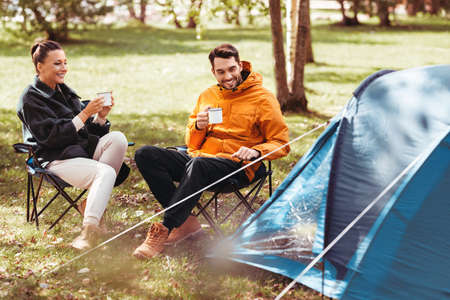1. The Rise of Ethical Outdoor Brands
In recent years, the outdoor industry has seen a major shift. More and more companies are embracing sustainability, not just as a trend but as a core part of their business model. These ethical outdoor brands are changing the way we think about camping gear—making it greener, cleaner, and better for the planet. At the same time, consumers are becoming more aware of their environmental impact and demanding products that align with their values.
Why Sustainability Matters in Camping Gear
When youre out in nature, it only makes sense to protect it. Traditional camping gear often uses materials like non-recyclable plastics, toxic dyes, or energy-heavy manufacturing processes. Ethical brands are flipping the script by choosing eco-friendly alternatives that reduce waste and pollution.
Key Factors Driving the Shift
- Consumer Awareness: Shoppers today are more informed about climate change and environmental issues.
- Brand Responsibility: Companies want to show they care about more than just profits.
- Innovation in Materials: New technologies make it easier to create high-performance gear using sustainable resources.
What Makes a Brand “Ethical”?
An ethical outdoor brand goes beyond using recycled materials. It looks at the entire lifecycle of a product—from sourcing and production to packaging and end-of-life disposal. Heres a quick breakdown:
| Feature | Description |
|---|---|
| Eco-Friendly Materials | Use of recycled fabrics, organic cotton, or biodegradable components |
| Fair Labor Practices | Ensuring safe working conditions and fair wages for workers |
| Sustainable Packaging | Minimal or recyclable packaging to reduce landfill waste |
| Product Longevity | Durable designs that reduce the need for frequent replacements |
The Consumers Role in the Revolution
The rise of ethical brands wouldnt be possible without conscious consumers leading the charge. Campers today arent just looking for high-performance gear—they also want products that align with their values. Whether its a tent made from recycled water bottles or a stove powered by renewable energy, every purchase is a vote for a more sustainable future.
2. Sustainable Materials Changing The Game
When it comes to eco camping gear, the materials used make all the difference. Ethical outdoor brands are leading a green revolution by using innovative, earth-friendly alternatives to traditional materials. These brands aren’t just reducing their environmental footprint—they’re setting new standards for what outdoor gear can be.
Recycled Fabrics: Giving Waste a Second Life
One of the most common sustainable materials in eco gear is recycled fabric. Brands now use recycled polyester made from post-consumer plastic bottles or fishing nets, turning trash into tough, durable tents and backpacks. This reduces landfill waste and cuts down on the need for virgin petroleum-based materials.
Popular Uses of Recycled Fabrics:
| Material | Source | Used In |
|---|---|---|
| Recycled Polyester (rPET) | Plastic Bottles | Tents, Jackets, Backpacks |
| Recycled Nylon | Fishing Nets & Fabric Waste | Packs, Outerwear |
Bio-Based Plastics: Nature-Inspired Innovation
Some brands are replacing petroleum-based plastics with bio-based alternatives made from plants like corn or sugarcane. These bioplastics offer similar strength and durability but break down more easily and have a much smaller carbon footprint.
Examples of Bio-Based Plastic Applications:
- Corn-based polymers: Used in tent stakes and utensils
- Sugarcane-derived EVA foam: Found in sleeping pads and sandals
Responsibly Sourced Down: Warmth Without Harm
Down insulation is prized for its warmth-to-weight ratio, but not all down is created equal. Ethical brands are turning to responsibly sourced down that ensures animals are treated humanely throughout the process. Look for certifications like the Responsible Down Standard (RDS) when shopping for sleeping bags or jackets.
Why Responsibly Sourced Down Matters:
| Feature | Benefit |
|---|---|
| No live-plucking or force-feeding | Animal welfare guaranteed |
| Traceable supply chains | Transparency from farm to product |
Sustainable materials arent just good for the planet—theyre also pushing outdoor gear to be lighter, stronger, and more comfortable than ever before. As more campers seek eco-friendly adventures, these innovative materials are setting a new benchmark for ethical exploration.

3. Top Eco-Friendly Camping Brands You Should Know
If youre passionate about camping and care about the planet, youll be happy to know that several American outdoor brands are leading the way in creating sustainable, high-performance gear. These companies are proving that you dont have to sacrifice style or durability to go green.
Leading U.S. Ethical Outdoor Brands
Here are some standout American brands making a real impact with their eco-conscious practices:
| Brand | Eco-Friendly Practices | Popular Products | Why It Stands Out |
|---|---|---|---|
| Patagonia | Uses recycled materials, fair trade certified, repairs gear for free | Sleeping bags, base layers, backpacks | Pioneer in environmental activism and transparency |
| REI Co-op | Sustainable product lines, carbon neutral operations by 2025 | Tents, camp furniture, outdoor apparel | Member-owned co-op with strong green values |
| NEMO Equipment | Zero-waste design approach, bluesign® certified fabrics | Tents, sleeping pads, camp pillows | Innovative designs focused on comfort and sustainability |
| Cotopaxi | Del Día line made from repurposed materials, B Corp certified | Packs, jackets, accessories | Colorful gear with a mission to fight poverty and promote sustainability |
| BioLite | Creates energy-efficient products using renewable energy sources | Camp stoves, solar panels, lighting systems | Cuts carbon emissions while bringing power to off-grid areas worldwide |
What Makes These Brands Different?
These companies go beyond just selling gear—they’re changing the way we think about camping and conservation. Whether it’s through using recycled fabrics, reducing carbon footprints, or giving back to communities, each brand is committed to protecting our natural playgrounds while enhancing your outdoor experience.
Sustainability Meets Performance and Style
No need to choose between function and ethics. These brands deliver top-notch performance that holds up in the wild—while looking great too. From ultra-light tents to cozy insulated layers made with recycled fibers, today’s eco-gear is smarter than ever.
The next time you’re stocking up for your outdoor adventures, consider choosing one of these ethical American brands. Supporting them means investing in a cleaner planet without compromising on quality or style.
4. Greener Production and Supply Chains
Ethical outdoor brands are changing the way camping gear is made by focusing on greener production and more responsible supply chains. These companies understand that sustainability isnt just about using recycled materials—its also about how products are manufactured, where they’re made, and who’s making them.
Localized Manufacturing for Lower Emissions
One major way eco-conscious brands are reducing their carbon footprint is by moving manufacturing closer to home. Instead of shipping materials and products across the globe, many are choosing local factories in the U.S. or nearby countries. This not only cuts down on transportation emissions but also supports local economies.
Benefits of Localized Manufacturing:
| Benefit | Description |
|---|---|
| Reduced Shipping Emissions | Less fuel used in transportation means fewer greenhouse gases released into the atmosphere. |
| Faster Turnaround Times | Products get to customers quicker with shorter shipping distances. |
| Support for Local Jobs | Manufacturing locally creates employment opportunities within the community. |
Carbon Offset Initiatives
Some ethical outdoor brands go a step further by investing in carbon offset programs. For every pound of CO2 they produce, they fund projects that remove or prevent an equal amount of emissions elsewhere—like planting trees, supporting renewable energy, or investing in clean water systems.
Examples of Carbon Offsetting Projects:
- Reforestation efforts in national parks and public lands
- Sponsoring solar panel installations for communities in need
- Partnering with certified carbon offset organizations like Carbonfund.org or Gold Standard
Ethical Labor Practices
Sustainability also includes how workers are treated. Ethical brands ensure safe working conditions, fair wages, and respect for labor rights across their supply chains. Many of them work with factories that are Fair Trade Certified or follow strict codes of conduct for employee welfare.
How Ethical Labor Makes a Difference:
- Dignity for Workers: Employees are paid fairly and work in safe environments.
- Transparency: Brands share information about where and how their products are made.
- Long-Term Partnerships: Companies build lasting relationships with manufacturers who share their values.
This combination of localized production, carbon offsetting, and ethical labor is helping eco-friendly outdoor brands lead the way toward a cleaner, more responsible future for campers everywhere.
5. The Future of Eco Camping Culture
As ethical outdoor brands continue to shape the camping gear industry, they’re also playing a big role in changing how Americans experience the outdoors. The future of eco camping culture is being shaped by sustainability movements and growing consumer awareness. More people are now choosing to camp with a purpose—minimizing their environmental impact while still enjoying nature.
Eco Movements Driving Change
Across the U.S., environmental awareness has grown thanks to global climate discussions, local conservation efforts, and social media influence. This shift is encouraging campers to rethink what they bring into nature—and what they leave behind. Movements like Leave No Trace have become mainstream, especially among younger generations who value eco-conscious living.
Key Principles from Leave No Trace
| Principle | Description |
|---|---|
| Plan Ahead and Prepare | Use eco-friendly gear, know the rules, and pack responsibly. |
| Travel and Camp on Durable Surfaces | Avoid damaging plants and wildlife habitats. |
| Dispose of Waste Properly | Pack it in, pack it out—including biodegradable items. |
| Leave What You Find | Don’t take natural souvenirs; let others enjoy them too. |
| Minimize Campfire Impact | Use portable stoves and follow local fire regulations. |
| Respect Wildlife | Observe animals from a distance and don’t feed them. |
| Be Considerate of Other Visitors | Keep noise down and respect shared public spaces. |
The Rise of Minimalist Packing
A big part of eco camping today is packing light and smart. Instead of bringing a carload of gear, more campers are choosing multi-use items made by ethical brands that use sustainable materials. This minimalist approach not only reduces waste but also makes camping simpler and more enjoyable.
Examples of Sustainable Gear Choices
| Traditional Item | Sustainable Alternative |
|---|---|
| Nylon Tent | Tent made from recycled PET or organic cotton canvas |
| Disposable Utensils | Bamboo or titanium reusable utensils |
| Bottled Water | Filtered water bottle with built-in purifier |
| Chemical Bug Spray | Plant-based insect repellent in recyclable packaging |
The Role of Ethical Brands in Education
Ethical outdoor brands aren’t just selling products—they’re also educating customers. Through blogs, social media, and packaging design, these companies share tips on reducing waste, following Leave No Trace principles, and making smarter purchases. Many even partner with nonprofits to support trail cleanups or tree-planting events across the country.
How Ethical Brands Are Making an Impact:
- PATAGONIA: Offers repair services and re-sells used gear through Worn Wear.
- TENTREE: Plants ten trees for every product sold and shares transparency reports online.
- COTOPAXI: Uses recycled materials and funds community projects through its foundation.
- BIO LITE: Designs energy-efficient stoves that also charge devices off-grid.
The eco camping lifestyle in America is evolving fast—thanks to informed consumers and innovative ethical brands. As this movement grows, we can expect more people to choose gear that’s good for both their adventures and the planet.


